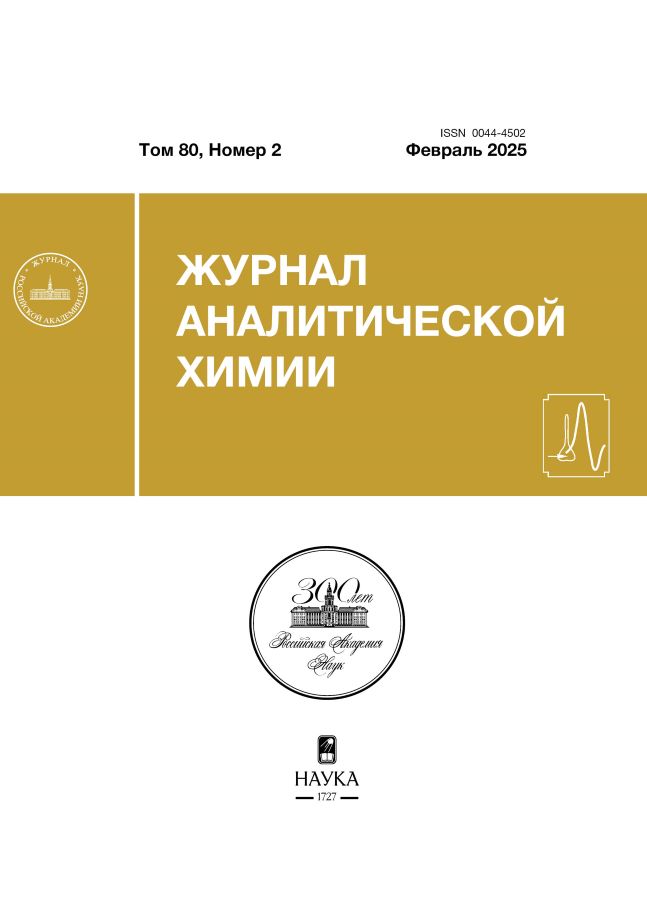One-Time Definition of Biologically Active Components of Rhodiola rosea in Extracts of Plant Sources by HILIC-MS/MS Method
- Autores: Nuikin S.A.1, Timchenko Y.V.1, Rodin I.A.1
-
Afiliações:
- Lomonosov Moscow State University
- Edição: Volume 80, Nº 2 (2025)
- Páginas: 189-200
- Seção: ORIGINAL ARTICLES
- ##submission.dateSubmitted##: 13.06.2025
- URL: https://rjraap.com/0044-4502/article/view/684155
- DOI: https://doi.org/10.31857/S0044450225020084
- EDN: https://elibrary.ru/aeldqo
- ID: 684155
Citar
Texto integral
Resumo
A simple, rapid and highly sensitive method for the simultaneous determination of the main components of Rhodiola rosea (rosin, salidroside, rosarin, and rosavin) in a wide range of concentrations by hydrophilic chromatography-tandem mass spectrometry has been developed. The conditions for extraction (type and composition of extractant, extraction time) of the main components from Rhodiola rosea root samples, chromatographic separation and detection of these compounds were selected, and the metrological characteristics of the proposed approach were evaluated. The detection limits were 250, 2.4, 2.3, and 5.4 ng/mL, and the linear ranges of detectable concentrations are 1–100, 0.01–10, 0.01–10, and 0.01–100 µg/mL for rosin, salidroside, rosarin, and rosavin, respectively. The developed approach is tested in the analysis of real samples of pharmaceuticals and plant raw materials.
Texto integral
Sobre autores
S. Nuikin
Lomonosov Moscow State University
Email: yury_tim@mail.ru
chemistry department
Rússia, MoscowYu. Timchenko
Lomonosov Moscow State University
Autor responsável pela correspondência
Email: yury_tim@mail.ru
chemistry department
Rússia, MoscowI. Rodin
Lomonosov Moscow State University
Email: yury_tim@mail.ru
chemistry department
Rússia, MoscowBibliografia
- Brown R.P., Gerbarg P.L, Ramazanov Z. Rhodiola rosea. A phytomedicinal overview // HerbalGram. 2002. V. 56. P. 40.
- Ghiorghita G., Maftei D.I., Maftei D.E. Rhodiola rosea L. – A valuable plant for traditional and for the modern medicine // An. Stiint. Univ. Al. I. Cuza Iasi. Mat. 2015. V. 61. № 1-2. P. 5.
- Родин И.А., Ставрианиди А.Н., Браун А.В., Шпигун О.А., Попик М.В. Одновременное определение салидрозида, розарина и розавина в экстрактах из Rhodiola rosea методом высокоэффективной жидкостной хроматографии с тандемным масс-спектрометрическим детектированием // Журн. аналит. химии. 2012. Т. 9. № 1. С. 61 (Rodin I.A., Stavrianidi A.N., Braun A.V., Shpigun O.A., Popik M.V. Simultaneous determination of salidroside, rosavin, and rosarin in extracts from Rhodiola rosea by high performance liquid chromatography with tandem mass spectrometry detection // J. Anal. Chem. 2012. V. 67. P. 1026.)
- Linh P.T., Kim Y.H., Hong S.P., Jian J.J., Kang J.S. Quantitative determination of salidroside and tyrosol from the underground part of Rhodiola rosea by high performance liquid chromatography // Arch. Pharm. Res. 2000. V. 23. P. 349.
- Bi H.M., Zhang S.Q., Liu C.J., Wang C.Z. High hydrostatic pressure extraction of salidroside from Rhodiola Sachalinensis // J. Food Process Eng. 2009. V. 32. № 1. P. 53.
- Filion V.J., Saleem A., Rochefort G., Allard M., Cuerrier A., Arnason J.T. Phytochemical analysis of Nunavik Rhodiola rosea L // Nat. Prod. Commun. 2008. V. 3. № 5. P. 721.
- Alperth F. Turek I., Weiss S., Vogt D., Bucar F. Qualitative and quantitative analysis of different Rhodiola rosea rhizome extracts by UHPLC-DAD-ESI-MSn // Sci. Pharm. 2019. V. 87. № 2. P. 1.
- Mao Y., Li Y., Yao N. Simultaneous determination of salidroside and tyrosol in extracts of Rhodiola L. by microwave assisted extraction and high-performance liquid chromatography // J. Pharm. Biomed. Anal. 2007. V. 45. № 3. P. 510.
- Ganzera M., Yayla Y., Khan I.A. Analysis of the marker compounds of Rhodiola rosea L. (golden root) by reversed phase high performance liquid chromatography // Chem. Pharm. Bull. 2001. V. 49. № 4. P. 465.
- Saunders D., Poppleton D., Struchkov A., Ireland R. Analysis of five bioactive compounds from naturally occurring Rhodiola rosea in eastern Canada // Can. J. Plant Sci. 2014. V. 94. № 4. P. 741.
- Tolonen A., Hohtola A., Jalonen J. Comparison of electrospray ionization and atmospheric pressure chemical ionization techniques in the analysis of the main constituents from Rhodiola rosea extracts by liquid chromatography/mass spectrometry // J. Mass Spectrom. 2003. V. 38. № 8. P. 845.
- Avula B., Wang Y.H., Ali Z., Smillie T.J., Filion V., Cuerrier A. et al. RP-HPLC determination of phenylalkanoids and monoterpenoids in Rhodiola rosea and identification by LC-ESI-TOF //Biomed. Chromatogr. 2009. V. 23. P.865.
Arquivos suplementares




















